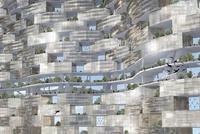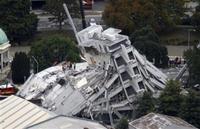-
Simulations helps overcome design challenges
Simulation software can pull volumes of complex data beyond simple measurements (think comparative load or stress tolerances) and layer that information into images; simulation can show how a bridge will perform based on how it is used, the conditions around it, its design, materials, and even variables such as the position of a joint — before a single component is manufactured or ground is broken
-
-
NICB warns of growing copper thefts
A recently released report by the National Insurance Crime Bureau (NICB) concludes that copper and other metal thefts are on the rise once again in the United States
-
-
U.S. files trade charges against China over rare minerals

China mines and sells about 97 percent of the world’s rare Earth elements – seventeen metals used in cell phones, advanced batteries, wind turbines, and more; the Chinese, in violation of WTO rules, have manipulated the export of these minerals in order to weaken the techno logy sectors of other countries, and punish countries over political disputes
-
-
New material for sustainable road building: "poticrete"
An organization dedicated to promoting sustainable roadway construction, awarded its first official certification to a Bellingham, Washington, project that incorporates porcelain from recycled toilets; a newly widened sidewalk in Bellingham incorporates more than 400 recycled toilets, crushed into what the project engineers have dubbed “poticrete”
-
-
Robots to climb and assemble structures, making construction safer

In the near future, armies of robots could nimbly be crawling up towers and skyscrapers to make repairs, so humans do not have to; the design of the truss pieces, which have ridges and specially designed locks so the robot can manipulate them, is as important as the robot itself, and researchers express the hopes that in the future such robot-friendly building components would be standardized for widespread use
-
-
Physicists predict when brittle materials fail
It does not happen often, but structures like bridges, airplanes, and buildings do fail, sometimes catastrophically; what are the odds, and how can it be prevented? Researchers just published new theoretical insights into the probability of structural failures, based on hundreds of thousands of computer simulations
-
-
Recycled glass in cement makes concrete stronger
Researchers have found that by mixing ground waste glass into the cement that is used to make concrete, the concrete is stronger, more durable, and more resistant to water; in addition, the use of glass helps reduce the amount of glass that ends up in landfills
-
-
Shape-memory alloys for earthquake-resistant structures

To improve the performance of structures during earthquakes, researchers have been investigating the use of “smart” materials, such as shape-memory alloys, which can bounce back after experiencing large loads
-
-
Smart paint monitors structural safety
An innovative low-cost smart paint that can detect microscopic faults in wind turbines, mines, and bridges before structural damage occurs; the environmentally friendly paint uses nanotechnology to detect movement in large structures, and could shape the future of safety monitoring
-
-
Building earthquake-proof buildings
Researchers in Australia are leading an international project to help identify buildings most vulnerable to earthquakes and the best ways to strengthen them
-
-
Improving pothole repairs
The alarming increase in the number of road potholes in the United Kingdom — an outcome of reduced road maintenance, increasing traffic volumes, heavier loads, and repeated adverse weather — is creating potentially hazardous driving conditions, causing serious concerns to the authorities as well as to the public; engineers are looking foe ways to improve pothole repairs
-
-
Changing bridge fabrication and inspection practices
As today’s engineers investigate the rebuilding of much of the nation’s infrastructure, a lot of which was constructed in the 1950s, they are using much improved materials and analysis tools; a Virginia Tech civil engineer predicts his new work on a fracture control plan for steel bridges promises to change bridge fabrication and inspection practices
-
-
Building design lessons from the Christchurch earthquake

A leading infrastructure expert believes an assessment needs to be made of the level of “very rare” earthquake that needs to be considered in structural design, perhaps one with a 10,000 year return period or higher, rather than the 500 year return period that is commonly adopted for many buildings in Australia
-
-
Increasing durability, cutting cost of railroad maintenance
Every year, companies that own railroad track across the United States spend millions of dollars maintaining ballast, the crushed rock underneath railroad ties and steel rails; in addition to the high cost, railroads must reroute trains around operations that maintain ballast, delaying the delivery of freight; researchers offer a solution
-
-
Engineering lessons of Fukushima
Many engineers and scientists are still examining what happened at Fukushima during the earthqyake and tsunami of 11 March; one group, a Tsunami Loads-and-Effects Subcommittee sponsored by the American Society of Civil Engineers (ASCE), is preparing to publish early next year an approximately 350-page report
-
- All
- Regional
- Water
- Biometrics
- Borders/Immig
- Business
- Cybersecurity
- Detection
- Disasters
- Government
- Infrastructure
- International
- Public health
- Public Safety
- Communication interoperabillity
- Emergency services
- Emergency medical services
- Fire
- First response
- IEDs
- Law Enforcement
- Law Enforcement Technology
- Military technology
- Nonlethal weapons
- Nuclear weapons
- Personal protection equipment
- Police
- Notification /alert systems
- Situational awareness
- Weapons systems
- Sci-Tech
- Sector Reports
- Surveillance
- Transportation
Advertising & Marketing: advertise@newswirepubs.com
Editorial: editor@newswirepubs.com
General: info@newswirepubs.com
2010-2011 © News Wire Publications, LLC News Wire Publications, LLC
220 Old Country Road | Suite 200 | Mineola | New York | 11501
Permissions and Policies
Editorial: editor@newswirepubs.com
General: info@newswirepubs.com
2010-2011 © News Wire Publications, LLC News Wire Publications, LLC
220 Old Country Road | Suite 200 | Mineola | New York | 11501
Permissions and Policies
